
French postcard by Cinémagazine-Edition, Paris. Photo: James Abbe.

With Natacha Rambova. French postcard by Cinémagazine-Edition, no. 129. Photo: James Abbe.
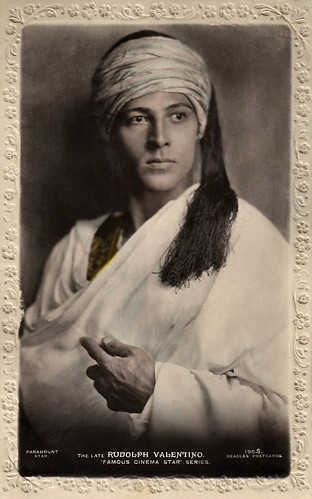
British postcard in the Famous Cinema Star Series by Beagles, no. 196.S. Photo: Paramount. Publicity still for The Sheik (George Fitzmaurice, 1921). Valentino wore the same costume in The Son of the Sheik, so we doubted for which of the two films this still was taken. However, Paramount was the producer of The Sheik.

German postcard by Ross Verlag, no. 4987/2, 1929-1930. Photo: Paramount. Publicity still for Blood and Sand (Fred Niblo, 1922).

German postcard by Ross Verlag, no. 3373/1, 1928-1929. Photo: United Artists. Publicity still for The Son of the Sheik (George Fitzmaurice, 1926).
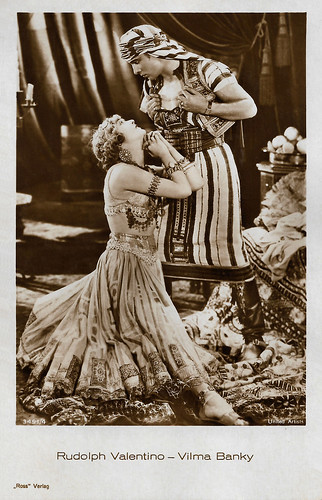
German postcard by Ross Verlag, no. 3491/4, 1928-1929. Photo: United Artists. Rudolph Valentino and Vilma Bánky in The Son of the Sheik (George Fitzmaurice, 1926).
Delicious little devil
Rudolph Valentino was born Rodolfo Alfonso Raffaello Pierre Filibert Guglielmi di Valentina d'Antonguella in 1895 in Castellaneta, Apulia, Kingdom of Italy. He had a French mother, Marie Berta Gabrielle née Barbin, and an Italian father, Giovanni Antonio Giuseppe Fedele Guglielmi di Valentina d'Antonguella, a veterinarian who died of malaria when Rodolfo was 11.
Unable to secure employment, the 18-years-old Rodolfo departed for the United States in 1913. In New York, the handsome young man supported himself as a taxi dancer (someone who danced with women for 10 cents a dance), among other occupations. In 1917, Valentino joined an operetta company that travelled to Utah, where it disbanded.
He then joined an Al Jolson production of 'Robinson Crusoe, Jr.' which was travelling to Los Angeles. By fall, he was in San Francisco with a bit part in a theatrical production of 'Nobody Home'.
While in town, actor Norman Kerry, helped Valentino land a few minor roles in films and by 1919 the young Italian was typecast as a shifty-eyed Latino villain.
He appeared as the second lead in The Delicious Little Devil (Robert Z. Leonard, 1919) with Mae Murray. He was credited Rudolpho De Valintine.
During this period he married small-time actress Jean Acker. Acker was a lesbian, involved in a love triangle with actresses Grace Darmond and Alla Nazimova, and the union with Valentino didn't last long.

Vintage postcard. Rudolph Valentino in The Four Horsemen of the Apocalypse (Rex Ingram, 1921). Madariaga "The Centaur" (Pomeroy Cannon), the richest man in Argentine, and his grandson, the handsome tango dancer Julio (Rudolph Valentino).

German postcard by Ross Verlag, no. 748/1. Photo: Bafag. Rudolph Valentino and Alice Terry in The Conquering Power (Rex Ingram, 1921).
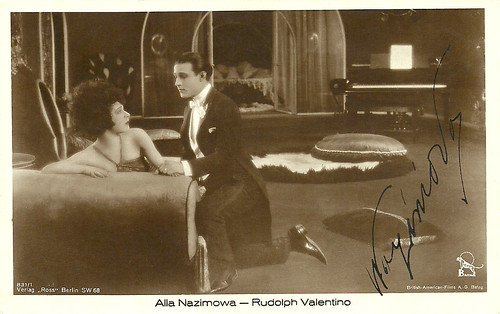
German postcard by Ross Verlag, no. 831/1, 1925-1926. Photo: British American Films / Balag. Collection: Didier Hanson. Publicity still for Camille (Ray C. Smallwood, 1921) with Alla Nazimova.

German postcard by Ross Verlag, Berlin, no. 831/2, 1925-1926. Photo: British-American-Films A.G. (Bafag). Publicity still for Camille (Ray C. Smallwood, 1921) with Alla Nazimova.

French postcard. Photo: Les Films Paramount. Rudolph Valentino in The Sheik (George Melford, 1921).
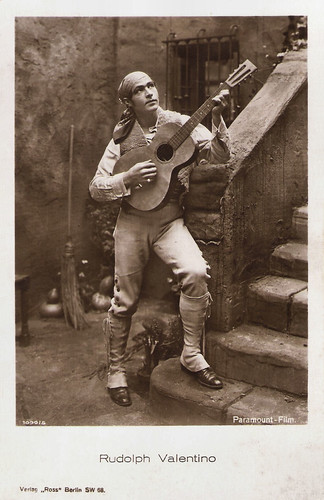
German postcard by Ross Verlag, no. 1090/5, 1927-1928. Photo: Paramount-Film. Publicity still for Blood and Sand (Fred Niblo, 1922).
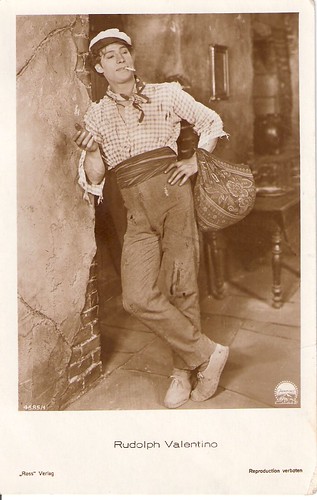
German postcard by Ross Verlag, no. 4685/1, 1929-1930. Photo: Paramount. Publicity still for Blood and Sand (Fred Niblo, 1922).
A unique brand of sexual charisma
Finally, in 1921, Rudolph Valentino's star potential was realised by screenwriter June Mathis, who convinced director Rex Ingram to cast Valentino as Julio Desnoyers in The Four Horseman of the Apocalypse (1921). A sensation was the scene in which he dances a sensual tango.
The Four Horseman of the Apocalypse became a critical success and was one of the first films to make $1,000,000 at the box office. It remains to this day the sixth-highest grossing silent film ever.
Valentino's unique brand of sexual charisma scored an immediate hit with the public, but Metro failed to capitalise on its new personality. For his follow-up film, the studio forced him into a B-film called Uncharted Seas (Wesley Ruggles, 1921). In this film, Valentino has one of the two leading male roles and, according to the synopsis, his part as a brave arctic explorer in love with the heroine was important. At the set, he met his second wife, Natacha Rambova.
Rambova, Mathis, Ivano, and Valentino began work on the Alla Nazimova film Camille (Ray C. Smallwood, 1921), based on the novel by Alexandre Dumas fils. Valentino was cast in the role of the idealistic young Armand, who falls in love with the older courtesan Camille (Nazimova). The film, mostly under the control of Rambova and Nazimova, was considered too avant-garde by critics and the public.
Valentino then accepted an offer at Famous Players-Lasky, the forerunner of the present-day Paramount Pictures. Here he co-starred with Agnes Ayres in The Sheik (George Melford, 1922), a role that would solidify his reputation as the ‘Latin lover’. Hal Erickson at AllMovie: “Despite the film's shortcomings, Valentino's magnetic personality permeated every frame, firmly establishing him as a star of the first rank.”
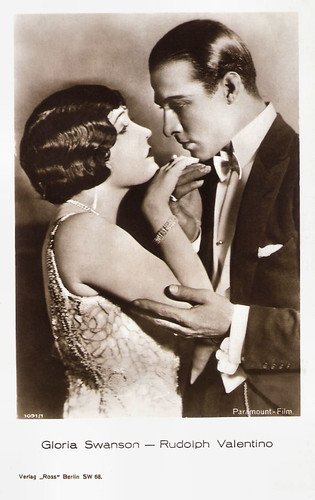
German postcard by Ross Verlag, Berlin, no. 1091/1, 1927-1928. Photo: Paramount-Film. Publicity still for Beyond the Rocks (Sam Wood, 1922) with Gloria Swanson.

Dutch postcard, 1924. Publicity card to promote The Young Rajah (Phil Rosen, 1922), which was presented in the Asta Theatre in The Hague, The Netherlands. Rudolph Valentino was in this film credited as Rodolph Valentino. The Young Rajah was reportedly a lost film, but a few years ago the last forty minutes of a nitrate print were discovered. Paramount used stills and trailers to reconstruct the film and did according to reviewer Ischlake on IMDb a very commendable job.

Austrian postcard by Iris Verlag, no. 372/4. Photo: Paramount-Film. Rudolph Valentino and Doris Kenyon in Monsieur Beaucaire (Sidney Olcott, 1924).

German postcard by Ross Verlag, no. 1766/2, 1927-1928. Rudolph Valentino in A Sainted Devil (Joseph Henabery, 1924).

German postcard by Ross Verlag, no. 1767/3, 1927-1928. Photo Stern Film Verleih. Rudolph Valentino and Helena D'Algy in the American silent film A Sainted Devil (Joseph Henabery, 1924).

German postcard for Ross Verlag, Berlin, no. 1787/2, 1927-1928. Photo: Famous Players-Lasky Corporation. Publicity still for A Sainted Devil (Joseph Henabery, 1924) with Louise Lagrange.
Pink powderpuff
Rudolph Valentino was rushed by Paramount from one film to another. He starred alongside Gloria Swanson in Beyond the Rocks (Sam Wood, 1922), but it was a critical disappointment.
Valentino began work on another Mathis-penned film, Blood and Sand (Fred Niblo, 1922), co-starring with vamp Nita Naldi. Valentino played the bullfighter Juan Gallardo. He initially believed the film would be shot in Spain and was upset to learn that the studio planned on shooting on a Hollywood backlot.
After finishing the film, Valentino married Rambova, which led to a sensational bigamy trial. The pair were forced to have their marriage annulled and separated for a year. Despite the trial, the film was still a success. Blood and Sand went on to become one of the top four grossing movies of 1922, and Valentino considered this one of his best films.
Valentino took a two-year sabbatical, devoting his time to writing and publishing poetry. He returned to the screen in such disappointing productions as Monsieur Beaucaire (Sidney Olcott, 1924) and Cobra (Joseph Henabery, 1925). A columnist for the Chicago Tribune characterised the actor as a 'pink powder puff'. Valentino angrily challenged the writer to a fistfight, but the waspish scrivener refused.
Valentino divorced his second wife Natacha Rambova and formed his own production company, playing virile leading roles in The Eagle (Clarence Brown, 1925) and Son of the Sheik (George Fitzmaurice, 1926), two of his best films.
A few months after completing Son of the Sheik, he was hospitalised in New York with a perforated ulcer. Complications quickly set in, and on 23 August 1926, the 31-year-old actor died. Nearly 80,000 hysterical women, including actress Pola Negri, crowded into Campbell's Funeral Parlour in New York.
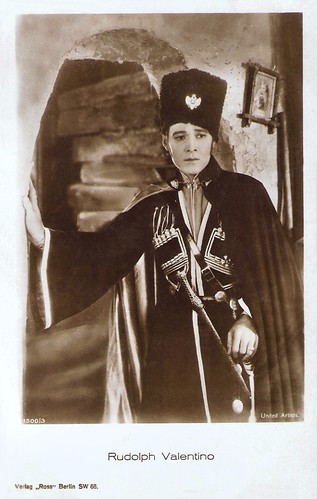
German postcard by Ross Verlag, no. 1500/3, 1927-1928. Photo: United Artists. Rudolph Valentino in The Eagle (Clarence Brown, 1925).
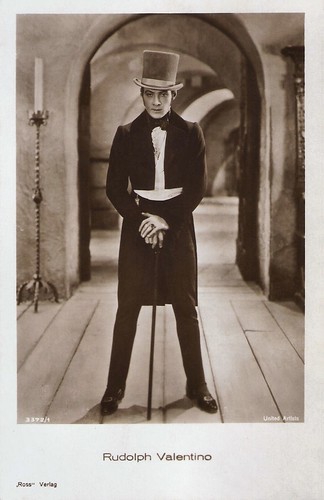
German postcard by Ross Verlag, Berlin, no. 3372/1, 1928-1929. Photo: United Artists. Rudolph Valentino in The Eagle (Clarence Brown, 1925).
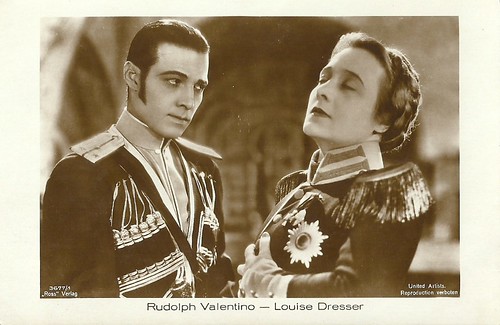
German postcard by Ross Verlag, no. 3677/1, 1928-1929. Photo: United Artists. Rudolph Valentino and Louise Dresser in The Eagle (Clarence Brown, 1925).

German postcard by Ross Verlag, no. 3676/1, 1928-1929. Photo: United Artists. Rudolph Valentino and Vilma Banky in The Eagle (Clarence Brown, 1925).

German postcard by Verlag Ross, Berlin, no. 1831/5, 1927-1928. Photo: Fanamet. Rudolph Valentino and Nita Naldi in Cobra (Joseph Henabery, 1925).
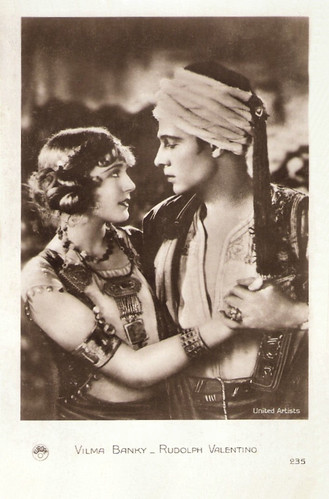
French postcard by Europa, no. 235. Photo: United Artists. Rudolph Valentino in The Son of the Sheik (George Fitzmaurice, 1926) with Vilma Banky.
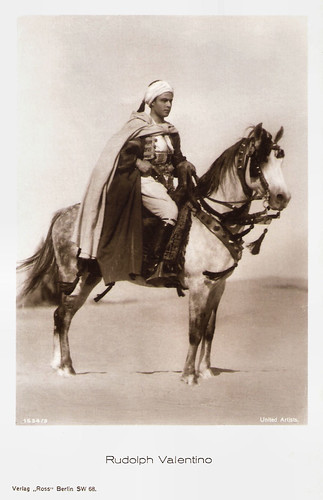
German postcard by Ross Verlag, no. 1534/3, 1927-1928. Photo: United Artists. Rudolph Valentino in The Son of the Sheik (George Fitzmaurice, 1926).
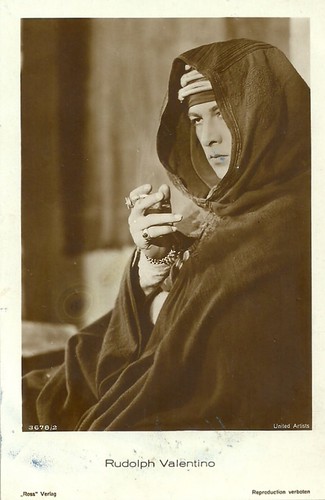
German postcard by Ross Verlag, no. 3678/2, 1928-1929. Photo: United Artists. Rudolph Valentino in The Son of the Sheik (George Fitzmaurice, 1926).

American postcard by California Postcard Co., Los Angeles, California, no. 26829N. Caption: Rudolph Valentino's Home, Hollywood, Los Angeles, California.
Sources: Hal Erickson (AllMovie), Wikipedia, and IMDb.
No comments:
Post a Comment